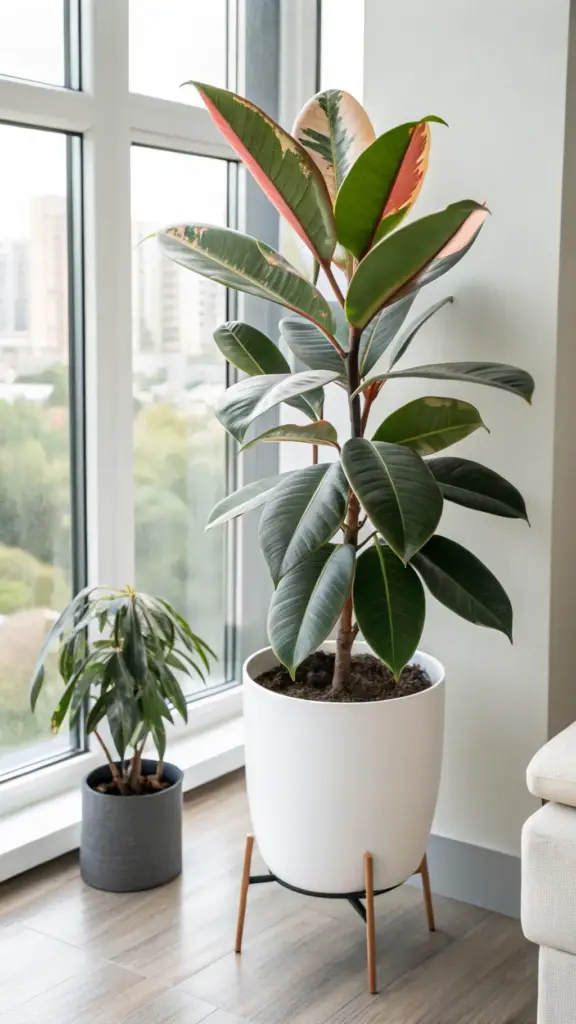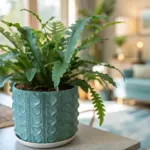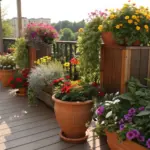3. Ficus elastica ‘Sophia’ – The Collector’s Crown Jewel

I’m not gonna lie – I hunted for a Ficus elastica ‘Sophia’ for almost two years before I finally found one. This plant is the unicorn of the rubber plant world, and when I say rare, I mean RARE.
The day I finally scored one from a private collector in California, I literally did a happy dance in my kitchen. My partner thought I’d lost my mind over a plant, but they just didn’t understand the significance.
Why This Plant is Practically Impossible to Find
The rarity factors surrounding ‘Sophia’ are pretty intense. Only a handful of mother plants exist worldwide, and most serious collectors aren’t willing to part with cuttings.
Limited availability stems from the fact that this variety was discovered as a single mutation in a European greenhouse around 2020. We’re talking about maybe 50-100 plants in circulation globally – that’s it.
Most specialty nurseries don’t even carry them because they can’t get their hands on propagation material. The few that do have waiting lists that are months long.
I’ve seen people pay$800+ for a single cutting with just two leaves. The plant world has gone absolutely bonkers for this variety, and honestly, I get it.
Those Incredible Leaf Characteristics
The leaf shape on ‘Sophia’ is completely different from any other rubber plant I’ve seen. Instead of the typical oval shape, these leaves are more elongated with pronounced pointed tips.
Coloration details are where this plant really shines. We’re talking cream, sage green, and the most delicate pink variegation that looks almost hand-painted.
The variegation pattern is what plant nerds call “sectoral” – meaning you get these distinct blocks of color rather than the marbled effect you see in other varieties.
New growth emerges with this incredible peachy-pink hue that gradually settles into more muted tones. Each leaf unfurling is like unwrapping a tiny present – you never know exactly what pattern you’ll get.
The leaf texture has this almost velvety quality when young, becoming more glossy as it matures.
Care Mistakes That’ll Break Your Heart
Here’s where I almost killed my first ‘Sophia’ – I treated it like a regular variegated plant. Big mistake that cost me some serious stress and money.
Specialized care requirements for this variety are no joke. These plants are incredibly sensitive to overwatering – more so than any other rubber plant I’ve grown.
I learned the hard way that ‘Sophia’ plants prefer to dry out completely between waterings. My first one developed root rot because I was watering every week like I do with other plants.
Light requirements are super specific too. Too much light bleaches out that gorgeous variegation, but too little causes the plant to revert to mostly green.
The sweet spot I’ve found is bright, filtered light for about 4-6 hours daily. East-facing windows with sheer curtains work perfectly.
Temperature sensitivity is another thing that caught me off guard. These plants hate sudden changes – keep them away from heating vents and drafty windows.
Investment Potential That’s Actually Crazy
Let’s talk numbers because the collector market trends for ‘Sophia’ are absolutely wild. I’ve watched small cuttings sell for$600-1200 depending on size and variegation quality.
Investment potential is something I never thought I’d consider with houseplants, but here we are. Well-established ‘Sophia’ plants have doubled in value over the past two years.
The resale market is incredibly active on platforms like Instagram and specialized plant Facebook groups. I know collectors who’ve made thousands just from propagating and selling cuttings.
Supply and demand economics are working in favor of early adopters. As more people discover this variety, prices just keep climbing.
Authentication is becoming a real issue too – I’ve seen fake ‘Sophia’ plants being sold as the real deal. Always buy from reputable sources with proper documentation.
Displaying This Million-Dollar Look
When you finally get your hands on a ‘Sophia’ plant, presentation is everything. This isn’t a plant you stick in a corner – it deserves center stage treatment.
I keep mine in a simple white ceramic planter that doesn’t compete with the incredible foliage. The variegation is the star of the show, so everything else should be minimal.
Lighting for display is crucial – I use a small grow light positioned about 2 feet away to ensure consistent illumination. The colors really pop under proper lighting conditions.
My favorite setup is on a plant stand near a large window with other high-end varieties. Creating a “premium plant corner” really showcases the investment quality.
Photography tips: These plants are incredibly photogenic, but the variegation can be tricky to capture. Natural morning light gives the most accurate color representation.
Ready to discover a variety that’s taking Instagram by storm with its incredible three-toned leaves? Click next to learn about the Ficus elastica ‘Belize’ – a tricolor wonder that’s become the holy grail for plant influencers everywhere!









GIPHY App Key not set. Please check settings